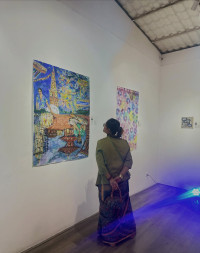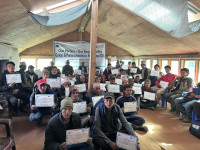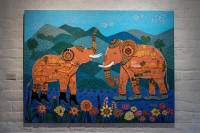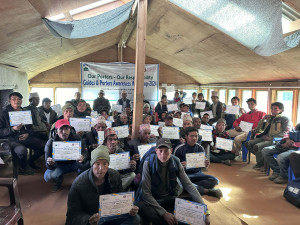Culture & Lifestyle
Feeling safe, seen and supported
Meaningful social interaction is vital for mental health, and its absence can lead to anxiety, depression, and burnout.
Reeva Khanal
Our mental health is influenced by the quality of our relationships and interactions with others. Whether through family, friends, colleagues, or community groups, social connections provide emotional support, a sense of belonging, and a buffer against stress. Understanding the powerful role that social bonds play in our emotional well-being is crucial, not just for surviving, but for thriving.
Ashim Sharma, a psychologist and counsellor at Mankaa Kura, highlights the quiet yet profound power of being seen, heard, and supported.
How do social connections influence an individual’s mental health and emotional well-being?
Humans are wired for connection—a fundamental need, not just a desire. From birth, we rely on relationships to feel safe and understood. One key benefit of connection is co-regulation, where being with someone can help us manage emotions, especially during stress.
When someone experiences trauma, parts of the brain responsible for speech, like Broca’s area, can shut down. That’s why it’s often hard to put painful experiences into words. But being in a safe, supportive relationship can help us find those words. Sharing our story with someone who listens can be healing. It shapes the chaos, helps us process what happened, and reminds us we’re not alone.
Social ties also offer protection from depression, anxiety, and burnout. Whether through friends, therapists, or loved ones, healing often begins in connection, not isolation.
Can the lack of meaningful social interaction contribute to mental health issues such as anxiety, depression, or burnout? If so, what are the underlying psychological mechanisms?
Absolutely. Meaningful social interaction is vital for mental health, and its absence can lead to anxiety, depression, and burnout.
Our brains are wired for connection. Feeling seen and supported activates the parasympathetic nervous system, calming the body and creating a sense of safety. Without it, we may remain in a constant state of fight-or-flight or emotional shutdown, which over time leads to fatigue, anxiety, or numbness.
Connection offers perspective and emotional relief—an empathetic presence can break the cycle of isolation and hopelessness. On a neurological level, positive social contact boosts oxytocin (the bonding hormone) and lowers cortisol (the stress hormone), helping regulate mood.
We also heal past relational wounds through new, safe experiences. For those who grew up with emotional neglect or criticism, consistent and kind connections can reshape how we relate to others and ourselves.
However, shallow relationships can worsen loneliness. Being around people without feeling known can feel even more isolating than being alone.
Have you observed any particular age groups who are more vulnerable to social isolation or loneliness?
Social isolation doesn’t belong to any one age group—it occurs across all stages of life, just in different forms.
In childhood, loneliness often begins at home—not from a lack of basic needs, but from a lack of emotional presence. Parents may be busy or assume material support is enough, but children also need attention, warmth, and connection. Without it, they can feel isolated—even in a full house.
For teenagers, social isolation tends to hit hardest among peers. This is the age where identity is forming, and the need to belong is intense. Feeling excluded, rejected, or left out can cause real emotional pain. In fact, research shows that the Anterior Cingulate Cortex, a part of the brain that processes physical pain, also lights up during experiences of social exclusion. So, when teens say it ‘hurts’ to be left out, it literally does.
In adulthood, loneliness often hides behind routines and responsibilities. People may have jobs and families, yet still lack someone they can open up to. It can also surface as a quiet loss of meaning—questions like ‘Who am I doing this for?’ or ‘Is this all there is?’
In late adulthood, isolation may stem from reduced mobility, illness, or the passing of long-time friends and partners. As making new connections becomes more difficult with age, many elderly individuals are left without regular, meaningful interaction—especially when family lives far away.
A lack of meaningful activity and community spaces- sometimes called ‘third spaces’ outside home and work—is another major contributor, particularly in fast-paced urban areas.
Certain groups are also more vulnerable across all ages. For example, people with disabilities, LGBTQ individuals, or women who are restricted to certain social roles or spaces may struggle to find genuine connection. They often face added layers of social judgment, invisibility, or exclusion.
How do Nepal’s cultural values and societal norms shape how people form or maintain social relationships in supportive and limiting ways?
Nepal’s cultural values strongly influence how people connect, and the influence is mixed—there are supportive aspects, but also limitations that can quietly shape how we relate to others and ourselves.
On the supportive side, our collectivist culture naturally builds in opportunities to connect—through festivals, marriages, rituals, and even funerals. People show up, even if out of courtesy or obligation. While this ‘showing face’ might seem superficial, it helps prevent total isolation. In fact, the structure of tradition often keeps social ties alive, even when emotional connection feels out of reach. And though it can feel like a burden, that effort sometimes becomes the thread that holds relationships together.
Nepali society remains tribal, valuing in-group loyalty—family, caste, class, or community—which fosters belonging but also fuels an ‘us vs them’ mindset. Social conformity is strong, with the fear of ‘what will people say?’ often overriding personal well-being. Maintaining harmony is prioritised, even at the expense of emotional authenticity or safety. Many, especially women and youth, learn to silence their feelings or identity to avoid shame or conflict.
There’s also systemic exclusion, whether based on caste, ethnicity, gender, or sexual orientation. Racism and classism are real, and they limit how freely people can form connections across social boundaries.
Nepal’s cultural norms can be both a safety net and a cage. They help people stay connected during difficult times, but they can also stifle individuality and emotional expression.
Do virtual or online connections offer the same mental health benefits as in-person interactions? Why or why not?
Online connections can be meaningful, but they generally don’t offer the same mental health benefits as in-person interactions. They do provide accessibility, allowing people to stay in touch across distances, connect more frequently, and find communities where none may exist locally. For those isolated by geography, illness, or anxiety, virtual spaces can be a lifeline. In that sense, something is often better than nothing.
Still, the brain and nervous system thrive on in-person cues. Humans are wired for co-regulation—the calming effect of being with a safe, attuned person. This depends on subtle nonverbal signals: eye contact, voice tone, facial expressions, and posture. These are often muted or lost in digital communication, especially through text or disrupted video.
Neuroscience tells us that safe face-to-face interactions activate the ventral vagal system (a branch of the parasympathetic nervous system), which helps us feel calm, socially engaged, and emotionally balanced. In virtual communication, that regulation is much weaker or missing entirely. You might leave a video call feeling more drained than nourished, even if the conversation was friendly.
Online connection is a bit like fast food—it can be satisfying in the moment but often lacks the deeper nourishment of real, in-person connection. That said, it depends on how we use it. A genuine video call with a close friend vastly differs from endless scrolling or surface-level texting.

What are some small but effective steps individuals can take to rebuild social connections if they are feeling isolated or disconnected?
Rebuilding social connections doesn’t have to start with something big. In fact, the smallest steps often matter the most, especially when we’re feeling isolated, anxious, or disconnected.
One of the most important first steps is to start with people who feel emotionally safe. That might be one friend, a cousin, a neighbour, or even someone online who listens without judgment.
Joining interest-based communities, workshops, or support groups—online or in person—can offer a more structured way to build connections.
Even taking a walk outside has benefits. From a somatic perspective, when we move through space, especially in nature or around people, we signal to the body that the world outside isn’t completely unsafe.
Could you share an anonymous example where improving one’s social connections contributed to mental health recovery or resilience?
Recovery and social connection often go hand in hand. One reinforces the other, and sometimes, building healthier relationships is what keeps someone going when little else helps. It’s about learning to connect differently—with more boundaries, awareness, and self-worth.
Let me share a case example, L, a client living abroad, had grown up with deep self-esteem issues. Even before leaving Nepal, he felt ‘less than’ in many spaces. After moving overseas, those feelings only got worse. He felt like an outsider—not just culturally, but also professionally. At work, he avoided conversations, doubted his abilities, and kept a low profile. His assumption was, ‘They won’t take me seriously anyway.’
This social withdrawal wasn’t just a side effect of low self-esteem—it was feeding it. That’s something we often see in therapy: poor mental health makes it harder to form and maintain relationships, but lack of connection also worsens mental health. It becomes a loop.
In therapy, alongside working with Gestalt techniques, Somatic Experiencing, and inner child work, we slowly started addressing his social patterns. He began experimenting with reaching out, sometimes just by showing up more authentically in small, low-risk conversations. He also started reconnecting with people from home, where he felt more grounded. As he practised these safer connections, something shifted.
He noticed that not everyone judged him the way he had assumed. He also began to experience being seen and received differently—not because the world had changed, but because he was meeting it from a different place within himself.
Science supports this: when we feel socially safe, our nervous system moves into a regulated state—we become calmer, more open, and more resilient. In L’s case, what helped most wasn’t simply “being more social,” but learning to connect in ways that felt safe, mutual, and aligned with his evolving self.




 7.12°C Kathmandu
7.12°C Kathmandu















